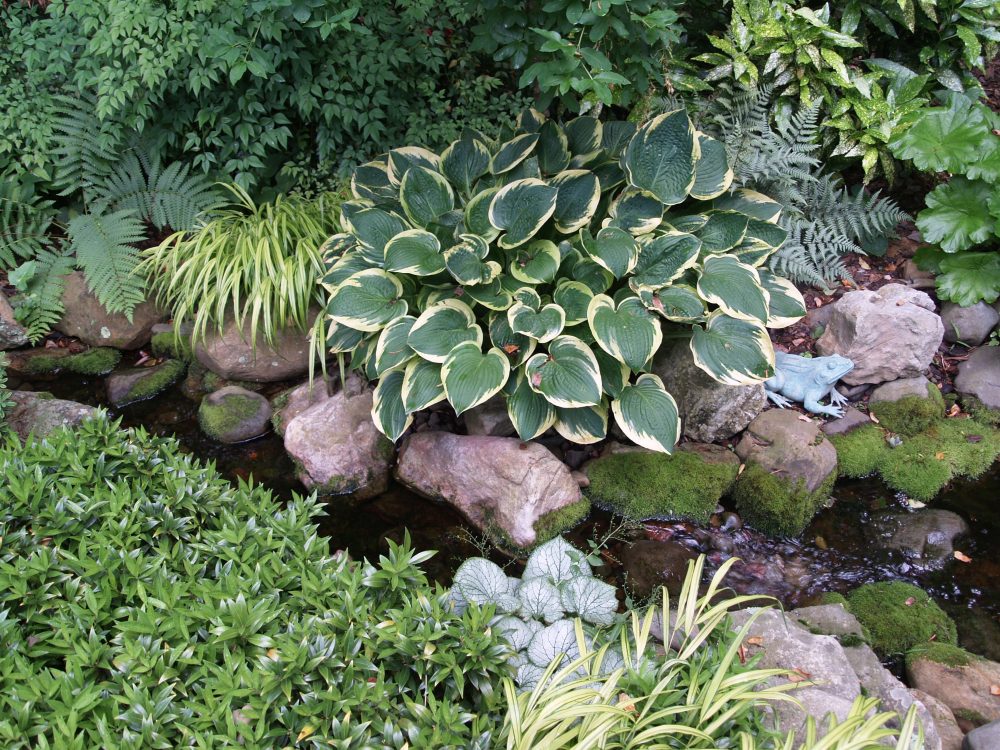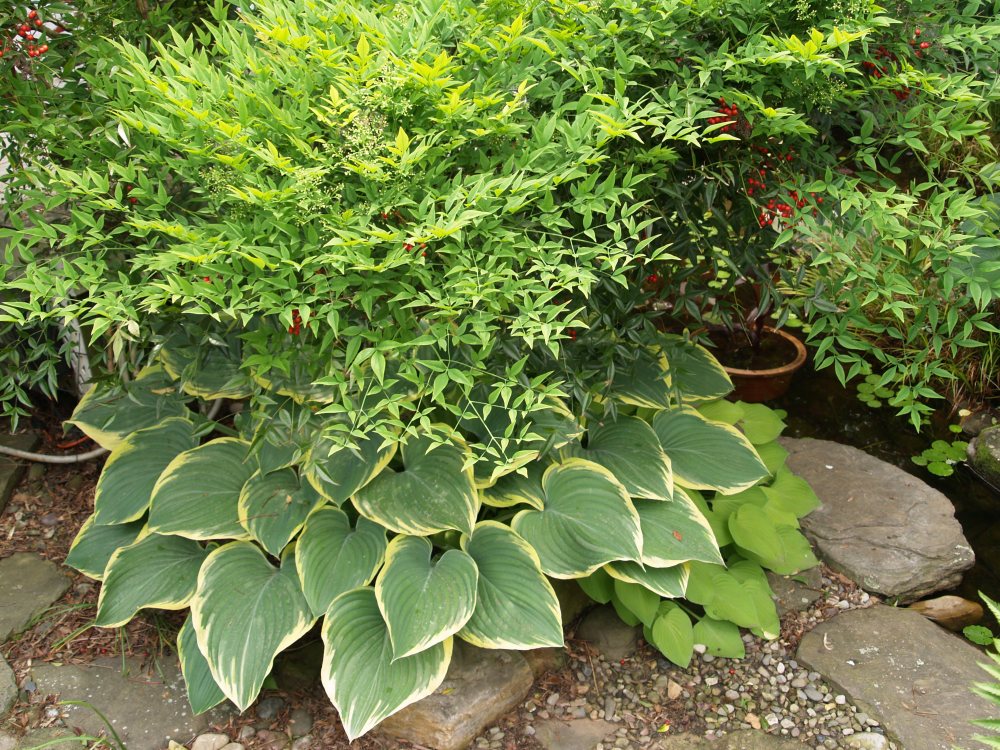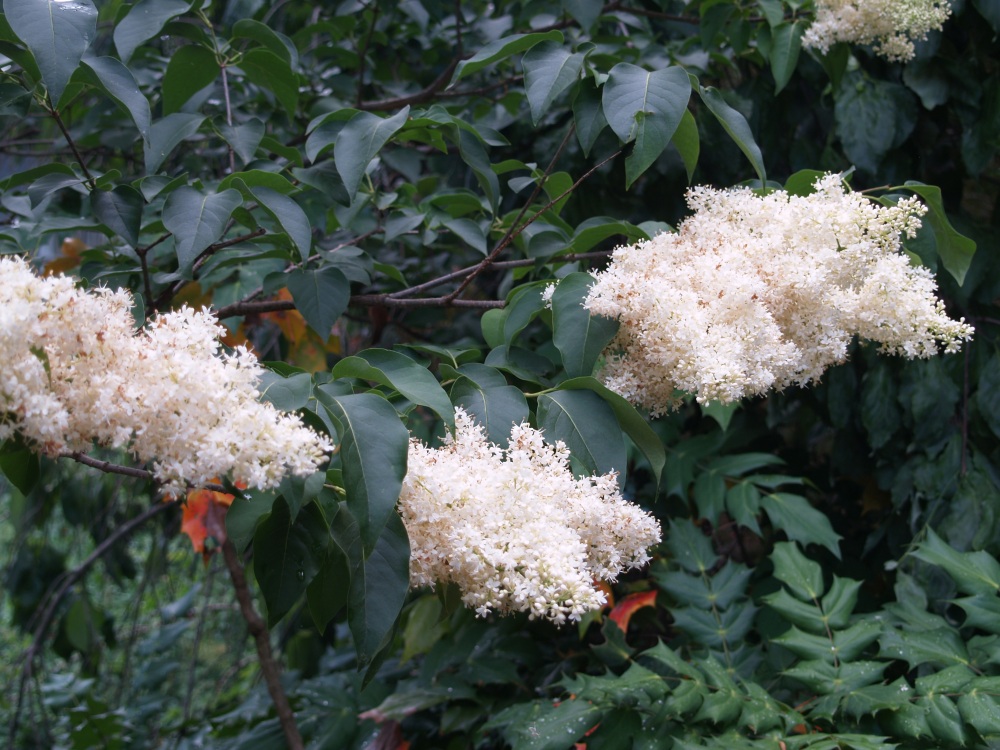Readers occasionally write asking for wider views of the garden rather than only close ups of flowers, and recently I’ve featured several of these. I often find that when I take photographs of more broad areas that the camera flattens the view so that there is too little contrast, with one plant hardly distinguishable from another. This is not the view as I travel through the garden.
The photo below was taken from a distance close enough so that each plant is clearly seen, partly, I think, because the foliage sizes, textures, and colors are distinctly different. Taken from ten feet further (which would not be possible since I would be standing in another pond, and behind tall nandinas) there would not be enough definition, and the photo would appear to be a jumble of green with a few splashes of yellow somethings (click on the photos to expand for a larger view).
The photos covers an area of perhaps eight feet square, and it occurred to me that this picture is somewhat of a summation of the garden. How many plants can be jammed into an area?
The most easily identifiable plants are the hosta (probably the common and durable Francee), two ferns (‘Ghost’ Japanese Painted and Autumn ferns), and Japanese Forest grass on either side of the small stream. The green foliage on the near side is a grouping of sweetbox (Sarcococca humilis), which has spread from a few spindly plants, and Nandina domestica on the far side. Above the nandina a branch or two of the pendulous Golden Chain tree dangles into the photo, and a bit of the yellow speckled Gold Dust aucuba has elbowed its way into the composition. From under the aucuba a few leaves of Darmera can be seen, and a silver leafed Brunnera struggles for space from under the sweetbox.
By my count there are ten different plants, eleven if the moss covered stones at pond’s edge are included. This number is either too many, or just right, depending on your gardening style, but for me, this is just about right. Of course, not every sixty square feet of the garden is so congested, but nearly every inch of ground in the nearly once acre of garden is covered with a plant of some sort.
With the start of June only a few days from today, the garden is at the point where vigorous and lush growth obstructs the stone paths, so that a visitor is thoroughly soaked from wet branches that must be brushed aside. The long blooming Chinese dogwoods remain in flower, though the blooms are now blemished and will fade shortly.
The late spring blooming magnolias are now flowering. The evergreen magnolias have suffered considerable damage from snow the past two winters, but they continue to bloom on the remaining branches. The deciduous Big Leaf magnolia (Magnolia macrophylla, above) blooms at the same time, but the huge leaves and flowers will never be mistaken as one of the glossy leafed evergreens.
The Japanese tree lilac (Syringa reticulata ‘Ivory Silk’, above) has large panicles of small white flowers, and though it is not so fragrant as the old fashioned common lilacs, I notice the scent as I walk nearby on a humid evening. Through ten years the tree lilac grew vigorously, but in a period of dry weather a year ago it suffered considerably with wilting foliage and some branches dying. This spring there is no sign of a continuing problem, but I am concerned that the heat of summer might inflict further injury.
There is so much more ground to cover today, but I must cut my writing short to keep up with some chores. With rain and heat any small spot that is not covered by foliage has sprouted a weed, or many dozens, and if I don’t keep after them regularly there will be trouble. I’ll return in a few days with an update on the garden’s ponds, and then later in the week we’ll catch back up with what’s blooming.
Oy, the weeds. In my tiny garden I can haul out a 5-gallon bucket of them with no problem if I let the issue stand for more than a week or so.
The contrasts of foliage in the area you’ve just shown is just great. Leafy greens for the win!
For efficiency I don’t bother hauling the weeds off. Most are plucked and tossed, where they die and melt away quickly enough that I’m not concerned with the appearance. Occasionally, the roots from one will grab some soil and sprout again, but rarely.
Love the lush look of your garden–I always say theres room for one more plant. I have a similar setting with woods all around an acre of grassy garden/water garden area. I would love to see how you handle where the grass meets the woods. Currently I have some hostas and daylillys and a few other shade loving plants at the woods edge but I find it hard to keep the weeds out and from having the woods creep too far in.
Most of the area along the wood line in my garden is planted with shrubs and small trees, viburnums, deciduous azaleas, assorted hydrangeas, and early spring blooming magnolias, serviceberry, and Carolina Silverbell. With lower plants in front of the taller forest trees the transition to hostas and other perennials is much easier.